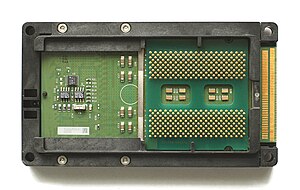Itanium 2

Itanium 2 processor
|
|
| Produced | From mid-2001 to present |
|---|---|
| Common manufacturer(s) |
|
| Max. CPU clock rate | 733 MHz to 2.53 GHz |
| FSB speeds | 300 MHz to 667 MHz |
| Instruction set | Itanium |
| Cores | 1, 2, 4 or 8 |

Itanium processor
|
|
| Produced | From June 2001 to June 2002 |
|---|---|
| Common manufacturer(s) |
|
| Max. CPU clock rate | 733 MHz to 800 MHz |
| FSB speeds | 266 MT/s |
| Instruction set | Itanium |
| Cores | 1 |
| L2 cache | 96 KB |
| L3 cache | 2 or 4 MB |
| Socket(s) |
|
| Core name(s) |
|

Itanium 2 processor
|
|
| Produced | From 2002 to 2010 |
|---|---|
| Designed by | Intel |
| Common manufacturer(s) |
|
| Max. CPU clock rate | 900 MHz to 2.53 GHz |
| Instruction set | Itanium |
| Cores | 1, 2, 4 or 8 |
| L2 cache | 256 KB on Itanium2 256 KB (D) + 1 MB(I) or 512 KB (I) on (Itanium2 9x00 series) |
| L3 cache | 1.5-32 MB |
| Socket(s) |
|
| Core name(s) |
|
Itanium (/aɪˈteɪniəm/ eye-TAY-nee-əm) is a family of 64-bit Intel microprocessors that implement the Intel Itanium architecture (formerly called IA-64). Intel markets the processors for enterprise servers and high-performance computing systems. The Itanium architecture originated at Hewlett-Packard (HP), and was later jointly developed by HP and Intel.
Itanium-based systems have been produced by HP (the HP Integrity Servers line) and several other manufacturers. As of 2008[update], Itanium was the fourth-most deployed microprocessor architecture for enterprise-class systems, behind x86-64, Power Architecture, and SPARC. The Poulson processor was released on November 8, 2012. While Intel said in April 2015 that it continued to work on Poulson's successor Kittson, Hewlett-Packard was the only remaining volume customer and even HP has since introduced Xeon-based machines. It appears that Kittson, announced for mid-2017, will be the last Itanium released, with a modest performance increase over Poulson. As of February 2016[update], Poulson was the most recent processor available.
...
Wikipedia
